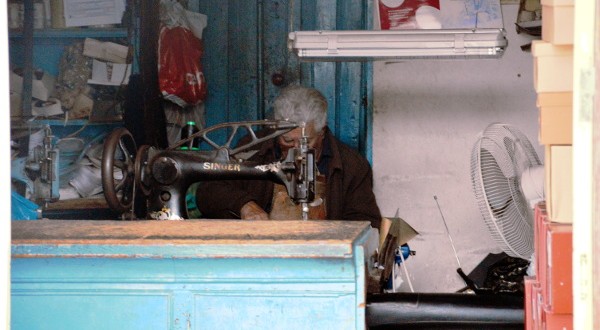In the upland town of Monchique, there are just three shoemakers, with a combined age of 240. They are the only ones to have survived the invasion of cheap footwear. These shoe craftsmen know how leather behaves, the stitches that are needed in the soles, they are the only ones who know how to fit heels and to transform old shoes into new.
The weight of the years is discernible in each of them, but they all continue to exercise their profession in whatever way they can, because they are passionate about their art. These shoemakers have dedicated their whole lives to footwear and now they can see their profession vanishing day by day. Aren’t there any young people in Monchique to continue the profession?
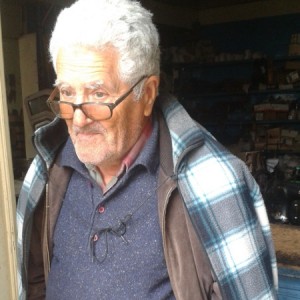
Seventy-one year old Vidaul Balbino has a small workshop covered in shoes of every description, as well as some rusty machines. He is the youngest of the three craftsmen still working in the town and the one who is coping best with the fact that his profession is coming to an end. As a professional, he is resigned to the end of his trade, and he says repeatedly: “it doesn’t bring anything in any more.” In an attempt to get customers to come to his shop, he keeps opening his doors day by day, depending on the weather and how he feels; if it’s raining or if it’s a Monday, you’ll find the doors closed. His age and his interest in business are not what they once were.
The shoemaker Vidaul Balbino has a number of boxes of shoes on display, brand new, for sale. He guarantees the client that any shoe bought from his shop is of the highest quality. He says that the shoes are totally produced in Portugal, where the triumph of Portuguese footwear is based on quality and design. However, on one of his walking-boots I tried on, the label betrayed its country of origin. “Made in the People’s Republic of China”. Why couldn’t it be produced in Monchique?
Yes. When I insisted on the importance of Portuguese shoes, he said he was ready to make them. He is the only one who is still prepared to make new shoes, but much of what he earns comes from small repairs.
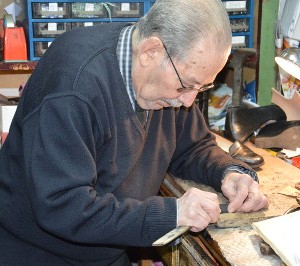
After walking a few dozen metres you come to an old sign, almost falling down, indicating the entrance to Senhor Fernando de Oliveira’s workshop, the oldest shoemaker in the town of Monchique, who is now 87 and started to “learn how to do this when I was 11 and left school. At that time there was 4th grade and that was pretty good, and so I started to learn how to do this with my father,” he told ECO 123. Up till then, this man, who is a good talker and has a broad, ready smile, had done what people normally do. But he had barely finished school when his father “immediately started to get me to work alongside him.” Apprentices spent hours watching the professionals, and years on end learning the profession. “That business of cutting out a paper pattern, you have to have the right technique and handle the knife and that takes time to learn,” he added. “This is a skilful craft.”
The shoemaker puts his hands where others put their feet. With his wrinkled hands, he was hitting the shoe on the iron form with the rounded end of the hammer. He loves what he does and can’t see himself doing anything else. And his physical condition would not allow him to. He is already at an advanced age. “I stopped making shoes because I’m on my own and there’s no way I can do that. Apart from that, I get these shoe mending jobs and if I do one thing I can’t do the other. Making shoes needs a lot of time including the cutting, it would take three days and in three days I can mend thousands of shoes. It means that less money is tied up, because it’s obviously different if you buy a piece of rubber that is enough for 10 or 12 pairs of shoes; if you buy leather it costs a fortune and is only enough for one pair of shoes.”
A new generation of young shoemakers doesn’t exist (yet), in a world where you can’t live without a pair of shoes. “To learn to be a shoemaker, the first thing you did was straightening nails, and it took weeks to perfect the technique. Then you were taught how to sew. Something it took a long time to perfect. Apprentices only learnt new things when they could do everything perfectly. But there aren’t any young people who are interested in learning this craft. There’s something very annoying about it, but not now because there’s no one who wants to do it,” the shoemaker lamented, distressed about the future of his profession.
Business in this trade does not ensure the sustainability of these professionals, but they keep going out of their passion for and dedication to their work, and because they are fully aware that the townspeople need their services: “The money I earn does not cover all my expenses. Sometimes I have to make do in different ways. And then I also only charge people once the work is done and people don’t always come to collect the shoes they left here and in the end I lose out.”
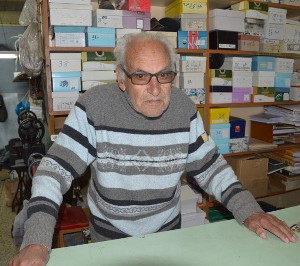
Another good example of passion for the art of footwear is the 82-year-old shoemaker António Andrés Martins, who is just a few metres further on. His premises are more sophisticated and have shoemaking equipment, half rusty, spread throughout the shop. He is satisfied with what he has achieved in the 68 years he has been working without interruption in the profession, which he learnt in humble workshops, often set up with a family’s small savings. He is not concerned about the fact that there are no youngsters wanting to learn the techniques of the craft he began at the age of 14. “There’s no way of changing this, the future of this is the factories and here in Monchique it’s not even being considered. Manual work has already ended here, and it must be ending in other places too,” the shoemaker says, adding “the old folk are coming to an end and the profession is too.”
There are always shoes to repair, no matter how modern the shoe industry may be. There are always customers who need to stick on half soles, or have a heel to be changed or painted; “what we need are new people to learn the trade and regenerate it,” says António Andrés Martins.
“When I learnt to be a shoemaker, over 68 years ago, there were another 40 apprentices in the workshop, but only a few of us remained in the profession. But I stayed, and it’s the only thing I know how to do reasonably well,” says António Andrés Martins, adding “I will keep doing this work until I die, even if there are fewer and fewer clients.”
That is what the lives of these professionals are like, but they keep going out of love for their craft, they contribute to modern society, with manual skills that no machinery or technology could replace: “I am going to cling on to this, I don’t want to close. I am passionate about it.”
The importance of shoemakers is not in doubt, we are all going to need them, but few people appear to attach any importance to the old professions like that of the shoemaker. The skills of making or repairing shoes are dying out. There are few shoemakers who can withstand the march of time. Some time ago, clients stopped depending on the services of a shoemaker, and the future looks bleak for those who have devoted their whole lives to footwear; however, when a shoe needs a new heel or when part of the shoe is damaged they don’t think twice about relying on the service of a professional.
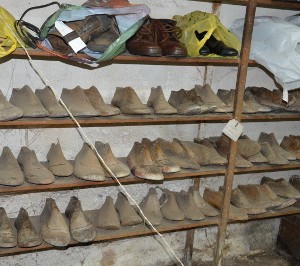 I, Daniela Guerreiro, have been walking through the streets of Monchique for just a short time. For a month, I have been up and down the village streets, looking in from the outside, with shoes that could come from Monchique. What shoes would we wear in Monchique? Boots for walking in the hills? Special footwear for agriculture? Smart shoes for the weekend, for going out dancing? Shoes to stop your feet getting cold? Orthopaedic shoes following an accident? Boots for the rain, and sandals and pumps for the summers?
I, Daniela Guerreiro, have been walking through the streets of Monchique for just a short time. For a month, I have been up and down the village streets, looking in from the outside, with shoes that could come from Monchique. What shoes would we wear in Monchique? Boots for walking in the hills? Special footwear for agriculture? Smart shoes for the weekend, for going out dancing? Shoes to stop your feet getting cold? Orthopaedic shoes following an accident? Boots for the rain, and sandals and pumps for the summers?
If there is a demand, there should always be a supply, and where there’s a will there’s a way. But what kind of journey do shoes go on? Almost all the cheap shoes cover a long distance and have one destination: the windows of the Chinese shops. Why? Why does almost no one ask, when they are buying shoes, about the conditions that they were made in? With what toxic chemicals the leather was tanned, be it with child labour or not? We talk about the economic crisis and only make it worse through negligence.
It is important to know where we have come from and where we are going. If we don’t watch out, more shops will close and our three old shoemakers will disappear from our lives and our memories. We will lose the history of this professional life and of the artisan production of good shoes, for ever. It is for us to pass on their experience to the next generation. If we know exactly who makes good shoes and where our new shoes are coming from, from where the leather and the fabric come, we can maintain our own identity and live proudly from our own history. And isn’t it important to give young people a good and useful lesson for their lives? I am aware that it can take a long time for decisions to be taken in Monchique. But people who have the courage to follow the right path, need to be in good health as well as having … good shoes.
 Eco123 Revista da Economia e Ecologia
Eco123 Revista da Economia e Ecologia

